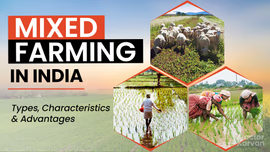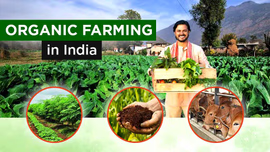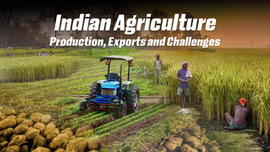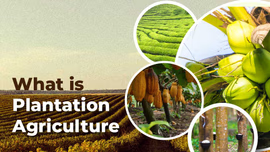What is Irrigation: Meaning, Techniques and Benefits

Table of Contents
- Introduction
- What is Irrigation?
- What are the Main Sources of Irrigation?
- What is the Status of Irrigation in India?
- What are the Different Types of Irrigation Techniques?
- What is the Importance of Irrigation for Indian Farmers?
- What are the Advantages of Irrigation?
- What are the Challenges of Irrigation Practices?
- Classification of Irrigation Projects
- What are the Government Schemes to Boost Irrigation?
Introduction
Irrigation feeds water to fields so that the crops absorb nutrients from the soil. It not only increases crop yield but also sustains agricultural operations in areas with low rainfall. However, irrigation comes with its own challenges. This is why modern irrigation practices focus on sustainability and water conservation.
If you are troubled by the question ‘What is irrigation?’, check out the following section.
What is Irrigation?
Supplying water to agricultural land to fulfil crop water requirement is called irrigation. Irrigation is mainly used to produce crops when there is irregular or low rainfall or in dry regions. Thus, it increases economic stability and food security.
Irrigation systems use a minimum amount of water to enable the healthy growth of plants and crops. The time, amount, rate and frequency of irrigation depends on the season as well as crop and soil type. For instance, summer crops need higher irrigation frequency due to more water loss through evapotranspiration.
However, you can face a range of issues like environmental degradation, salinization and waterlogging due to excessive watering. Thus, there is a need to adopt efficient and sustainable irrigation practices to ensure environmental balance and lasting agricultural productivity.
What are the Main Sources of Irrigation?
Water is among the key factors for crop production in the agriculture sector. Both intensive and extensive land cultivation is hugely reliant on water availability. There are several irrigation sources in India, including springs, tube wells, tanks, canals and open wells.
What is the Status of Irrigation in India?
Agriculture is responsible for around 80% of the available water use annually. It accounts for nearly 700 billion cubic meters. Farmers still depend on the monsoon season (June-September) to water most of the summer-sown or kharif crops.
52% of the gross sown area in India had irrigation access in 2022-23. This irrigated area is around 73 million hectares. Of this, around 11% of area have facilities for micro-irrigation via drip systems and sprinklers. 40% of the total irrigated area is watered with the help of canal networks. The rest of the area uses groundwater.
What are the Different Types of Irrigation Techniques?
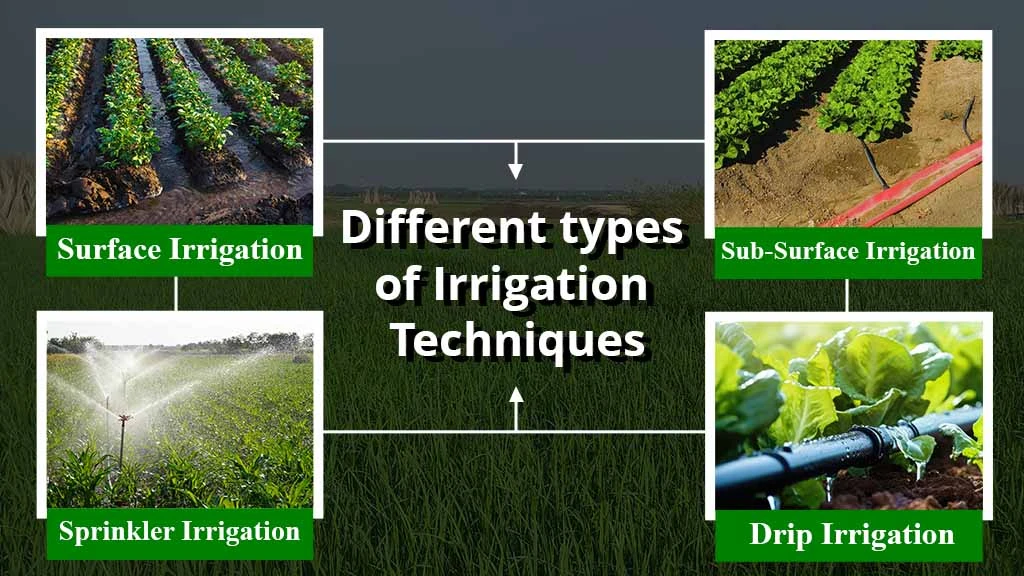
An irrigation technique is based on the distribution of obtained water within fields. The aim is to supply water in the field uniformly. It allows each plant to receive the required amount of water for healthy growth. Following are the different irrigation techniques:
Surface Irrigation
Water is supplied over and across the field in surface irrigation systems. They wet the land using gravity flow and ensure water infiltrates the soil. Surface irrigation is further categorized into:
- Furrow: The ridge and furrow method of irrigation creates furrows or small channels along the contour of the field. Water moves in these furrows and is absorbed by the soil around the root zones of crops. Furrow irrigation is best suited for orchards and row crops. If it is not done correctly, it may cause soil erosion and uneven water distribution.
- Border strip: Borders or long, narrow strips are created to divide a sloping field. Low ridges border them to carry water. Water is supplied from the higher border end so that gravity moves it throughout the strip. Along the path, it irrigates the plants.
- Basin: For basin irrigation, basins or shallow depressions are formed around individuals or groups of plants. These basins are supplied water directly so the soil around the plants absorbs it. Small layout fields are most suitable for basin irrigation.
Sub-Surface Irrigation
Sub irrigation, also known as seepage irrigation, is a technique of delivering water to the plants from beneath the root zone. This advanced landscaping technology focuses on the correct utilization of water resources and even water distribution in the required area for better outcomes.
This system includes water emitters and delivery lines installed below the surface of soil for distributing water directly to the soil from under the surface. This prevents airborne drift and runoff. It also eradicates surface water evaporation along with recurrence of weeds and diseases. water evaporation and it is highly suitable for windy, semi-arid, and hot areas. When it comes to soil, sandy-type soils are considered best for installing sub-surface irrigation systems.
Sprinkler Irrigation
In the case of shallow, highly arable and porous soil and uneven topography, this irrigation method is practiced. At the seedling stage, sprinkler irrigation method is extremely beneficial. Water is sprayed under pressure with the help of a network of pipes via nozzles or jets.
This system ensures uniform water distribution and can be implemented in various soil types. Also, you can easily apply water-soluble fertilizers and operate farm implements without hindrance. However, it comes with a high initial cost and strong winds can result in uneven water distribution.
Drip Irrigation
Drip or trickle irrigation is an irrigation technique which as the name suggests allows water to drip slowly to the roots of the crops either directly on the soil surface or onto the root zone. The system consists of a network of valves, pipes, tubing, and emitters. Modern agriculture uses plastic mulch in drip irrigation to reduce evaporation even more. It is one of the most water-efficient irrigation methods if utilized appropriately.
What is the Importance of Irrigation for Indian Farmers?
Irrigation is one of the most essential factors responsible for the appropriate absorption of nutrient elements by the crops from the soil. It is also responsible for enabling growth and photosynthesis in Plants. It stabilizes the output and yields. Along with this, irrigation plays a crucial role in conservation of depleting resources, specially, the groundwater resources. India is the leading exploiter of groundwater and therefore modern agriculture irrigation practices provide efficient and sustainable use of water in farming. Moreover, around 50% of the net sown area in India is rainfed. There is a considerable difference in rainfall with regard to time and space. Thus, effective irrigation methods can not only reduce the dependency on the rain but also reduce the huge risk of dry spells which are capable of causing damage at critical growth stages.
What are the Advantages of Irrigation?
India has diverse weather and climate conditions. Irrigation serves a key role in ensuring adequate soil moisture for optimal crop growth. Other key benefits of irrigation are:
- Reduction in Poverty: Due to effective irrigation practices, the area under cultivation increases across the country. It helps reduce poverty by generating employment and favoring increased food production.
- Conservation of Water: Modern irrigation practices ensure that water is applied precisely to the root zones of plants. Thus, there is less water wastage than traditional irrigation practices.
- Sustainable Agriculture: Irrigation promotes sustainable agriculture and reduces dependence on monsoons. It helps farmers to plan cultivation and water usage efficiently. Thus, water resources are conserved, and there is less waste.
- Drought Mitigation: Farmers can ensure suitable soil moisture using irrigation even during dry spells and low rainfall. You can provide sufficient water to crops, ensuring they do not die during hot periods.
- Higher Crop Yield: Without irrigation, farmers will have to depend on rainwater, which is sometimes unpredictable and insufficient in quantity. Crops receive the required amount of water at the correct time with the help of irrigation. Thus, they thrive, resulting in higher yields and higher produce quality.
What are the Challenges of Irrigation Practices?
The following are the main challenges of agriculture irrigation practices:
- Because of poor water irrigation practices, soil can turn saline. Also, a lack of proper drainage can cause waterlogging. These activities result in crop damage and yield loss.
- Big irrigation projects in India face criticism from farmers in relation to their operation and management. The bureaucratic or top-down approach is not considered helpful for the local farming community.
- Improper and intensive use of water and land resources question the sustainability aspect of irrigation.
- Reservoirs face the extreme challenge of siltation. Due to sedimentation, reservoir storage is reduced.
Classification of Irrigation Projects
In India, there are three categories of irrigation projects:
- Major Irrigation
- Medium Irrigation
- Minor Irrigation
A project with a Cultivable Command Area (CCA) of over 10,000 hectares is a Major Project. If CCA is between 2,000-10,000 hectares, it is a Medium Project. Minor projects have a CCA of less than or equal to 2,000 hectares. The source for minor irrigation projects is ground and surface water. Medium and Major projects generally use surface water resources.
The 6th minor irrigation census reveals that there are 23.14 million schemes for minor irrigation in India. Out of this, Uttar Pradesh has the biggest share of 17.2%. It is followed by Maharashtra, Madhya Pradesh, Tamil Nadu and Telangana.
What are the Government Schemes to Boost Irrigation?
During 2015-16, the government of India introduced the Pradhan Mantri Krishi Sinchayee Yojana (PMKSY). Its goal is to ensure that physical access to water on farms is enhanced. Other key objectives include sustainable water conservation practices, better on-farm water use efficiency and the expansion of cultivable areas.
This umbrella scheme involves several components:
- Har Khet Ko Pani (HKKP): HKKP aims to expand the cultivable area that is under assured irrigation. Command Area Development & Water Management (CADWM) ensures its funding.
- Accelerated Irrigation Benefit Programme (AIBP): This flagship programme offers financial assistance to irrigation projects. It aims to accelerate the completion of projects that lack state resources.
- Per Drop – More Crop: This component is mainly focused on micro-irrigation and aims to enhance water use efficiency on farms. It promotes several activities like sprinkler irrigation and drip irrigation.
- Watershed Development: It deals with managing runoff effectively. This component also involves activities for soil and moisture conservation like drainage line treatment, in-situ moisture conservation, rainwater harvesting and ridge area treatment.
Conclusively, irrigation is essential for the healthy growth of crops. Multiple irrigation systems can be used to provide water to crops. Farmers must adopt efficient irrigation techniques so that their crops get sufficient water during their growth phase while being sustainable.
Frequently Asked Questions On What is Irrigation: Meaning, Techniques and Benefits
1. What is irrigation?
Irrigation means providing water to crops for their healthy growth using artificial means.
2. How to winterize an irrigation system?
You can winterize the irrigation system using several methods, such as insulating your assets, draining the pipes and protecting valves.
3. What is drip irrigation?
Drip irrigation delivers water drop by drop near the root zones of crops.


Related Blogs
